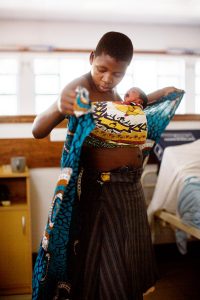
Fra artikkel i Redd Barna-magasinet 3/2016: Premature babyer reddes ved hjelp av kengutu-metoden og amming. Vi er på nyfødtavdelingen ved Queen Elizabeth Central Hospital i Blantyre, landets nest største by. Her er det opprettet en egen Kenguru-avdeling, der mødre til premature barn får hjelp til å håndtere de bittesmå babyene. Hudkontakten og varmen fra morens kropp gjør at for tidlig fødte babyer kan overleve uten tilgang på kuvøser, maskiner som overvåker pusting eller annet avansert utstyr. Slikt er det altfor lite av på sykehusene i Malawi. De få kuvøsene vi ser på nyfødtavdelingen er gamle og utdaterte, og det ligger gjerne 3-4 babyer i hver. Men det disse barna trenger er ikke først og fremst kuvøser; det er tettere kontakt med mor som redder livene deres. «Hvert eneste barn er en gave» - Enkelt, billig og effektivt. Fint for både mor og barn. Prosjektleder Lydia Chimtembo i Redd Barna kan ikke få rost kenguru-metoden nok. Ideen er at sårbare premature babyer har det best hud mot hud, og at barna skal svøpes på mammas bryst slik at det etterligner kenguru-lommen. Når babyen ligger inn til mamma døgnet rundt, er den sikret både varme og brystmelk. Kenguru-metoden ble første gang prøvd ut ved et av Malawis sykehus i 1999. I dag har alle sykehus i landet tatt i bruk metoden, men i begrenset grad. - Noen praktiserer den mer enn andre, forteller Chimtembo. – Dessverre synes ikke enkelte at det er bryet verd å prøve å redde de minste barna. Men hvert eneste barn er en gave, og vi skylder å gi det en sjanse til å overleve og vokse opp, sier hun.
Background
Coverage of kangaroo mother care remains very low despite WHO recommendations for its use for babies with low birthweight in health facilities for over a decade. Initiating kangaroo mother care at the community level is a promising strategy to increase coverage. However, knowledge of the efficacy of community-initiated kangaroo mother care is still lacking. We aimed to assess the effect of community initiated kangaroo mother care provided to babies weighing 1500–2250 g on neonatal and infant survival.
Methods
In this randomised controlled, superiority trial, undertaken in Haryana, India, we enrolled babies weighing 1500–2250 g at home within 72 h of birth, if not already initiated in kangaroo mother care, irrespective of place of birth (ie, home or health facility) and who were stable and feeding. The first eligible infants in households were randomly assigned (1:1) to the intervention (community-initiated kangaroo mother care) or control group by block randomisation using permuted blocks of variable size. Twins were allocated to the same group. For second eligible infants in the same household as an enrolled infant, if the first infant was assigned to the intervention group the second infant was also assigned to this group, whereas if the first infant was assigned to the control group the second infant was randomly assigned (1:1) to the intervention or control group. Mothers and infants in the intervention group were visited at home (days 1–3, 5, 7, 10, 14, 21, and 28) to support kangaroo mother care (ie, skin-to-skin contact and exclusive breastfeeding). The control group received routine care. The two primary outcomes were mortality between enrolment and 28 days and between enrolment and 180 days. Analysis was by intention to treat and adjusted for clustering within households. The effect of the intervention on mortality was assessed with person-time in the denominator using Cox proportional hazards model. This study is registered with ClinicalTrials.gov, NCT02653534 and NCT02631343, and is now closed to new participants.
Findings
Between July 30, 2015, and Oct 31, 2018, 8402 babies were enrolled, of whom 4480 were assigned to the intervention group and 3922 to the control group. Most births (6837 [81·4%]) occurred at a health facility, 36·2% (n=3045) had initiated breastfeeding within 1 h of birth, and infants were enrolled at an average of about 30 h (SD 17) of age. Vital status was known for 4470 infants in the intervention group and 3914 in the control group at age 28 days, and for 3653 in the intervention group and 3331 in the control group at age 180 days. Between enrolment and 28 days, 73 infants died in 4423 periods of 28 days in the intervention group and 90 deaths in 3859 periods of 28 days in the control group (hazard ratio [HR] 0·70, 95% CI 0·51–0·96; p=0·027). Between enrolment and 180 days,158 infants died in 3965 periods of 180 days in the intervention group and 184 infants died in 3514 periods of 180 days in the control group (HR 0·75, 0·60–0·93; p=0·010). The risk ratios for death were almost the same as the HRs (28-day mortality 0·71, 95% CI 0·52– 0·97; p=0·032; 180-day mortality 0·76, 0·60–0·95; p=0·017).
Interpretation
Community-initiated kangaroo mother care substantially improves newborn baby and infant survival. In low-income and middle-income countries, incorporation of kangaroo mother care for all infants with low birthweight, irrespective of place of birth, could substantially reduce neonatal and infant mortality.